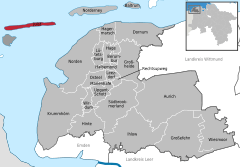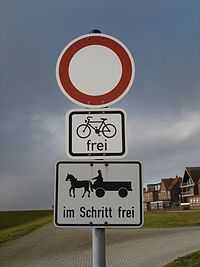Juist
| Juist | |||
|---|---|---|---|
 | |||
| |||
 Juist | |||
Location of Juist within Aurich district 
 | |||
| Coordinates: 53°40′43″N 6°59′51″E / 53.67861°N 6.99750°ECoordinates: 53°40′43″N 6°59′51″E / 53.67861°N 6.99750°E | |||
| Country | Germany | ||
| State | Lower Saxony | ||
| District | Aurich | ||
| Subdivisions | 2 districts | ||
| Government | |||
| • Mayor | Dietmar Patron | ||
| Area | |||
| • Total | 16.43 km2 (6.34 sq mi) | ||
| Elevation | 3 m (10 ft) | ||
| Population (2012-12-31)[1] | |||
| • Total | 1,509 | ||
| • Density | 92/km2 (240/sq mi) | ||
| Time zone | CET/CEST (UTC+1/+2) | ||
| Postal codes | 26557–26571 | ||
| Dialling codes | 04935 | ||
| Vehicle registration | AUR | ||
| Website | www.juist.de | ||
Juist (German pronunciation: [ˈjyːst]) is one of the seven inhabited East Frisian Islands at the edge of the Lower Saxon Wadden Sea in the southern North Sea, located between Borkum Island (west), Memmert Island (southwest) and Norderney (east). It is also a municipality in the district of Aurich in Lower Saxony in Germany.
Juist is 17 km long and 500 m to 1 km wide (this depends on the level of tide, which sinks and falls about 2.5 m in 6 hours). There are two villages on the island: the main village Juist, and Loog.
Transportation

Juist can be reached from Norddeich train station and ferry port on the East Frisian mainland by the ferries of Reederei Norden-Frisia Frisia II, Frisia VI, Frisia IX, Frisia X at high tide - that means usually only once a day.
A non-tide-dependent way to reach the island is offered by the Airline FLN, though the weather conditions are sometimes - especially in winter - so bad that the airline has to cancel all flights for a day. Their 4-seat Cessna and their four 10-seat Britten-Norman Islanders serve Juist airport, which has the second highest number of movements in Lower Saxony after the capital airport Hannover.
The passage by ship takes - depending on the wind and the water level - about 90 minutes; a flight takes just 7 minutes.
Only the fire department, the German Red Cross and doctors have motor vehicles - the police have only 'office bikes'. The post office and the shipping company each have one electric car. Some institutions like the shipping company and a branch of the Coastal defence authority have tractors, but need a special license, every time they want to navigate through the town. All other transports like garbage collection, building material, guest luggage, pizza service etc. are done by bike or horse-drawn carriage.
'Skyline'

What people can see from the North Sea as 'skyline' are just two buildings: the water tower and an old hotel, which looks a bit like the German Reichstag since its restoration. The lighthouse at the port is not high enough to be seen from the North Sea - has no nautical importance, not even for the ferries to the island. Its use is rather to make the port area look nicer.[citation needed]
Hammersee
A natural specialty is lake Hammersee, a fresh water lake in the western third of the island. In the 17th and 18th century Juist was cut in two parts by several storm tides (see St. Peter's Flood). Around the year 1770 people started to close the 2 km wide burst at the southern side by a dune dike. As recently as 1928 the northern side was repaired. By that time, the water in the lake had turned from saltwater to freshwater. Sinead Morrissey's poem 'Restoration' uses Juist as a metaphor for isolation.
Sweet water, where salt water is all around
Juist is - seen with the geologist's eye - nothing but sand. Rain water which drips into the sand has a lower density than saltwater, which makes a kind of fresh water bubble float over the saltwater around and deep under the island. That's why Juist island does not have a fresh water pipeline to the mainland - and it is also what made the Hammersee turn into a fresh water lake.
Bill - Westend
Bill is northern German dialect word for 'butt' and 'end'.
At the western end of Juist, there is a large sandbank, the "Billreef". It looks absolutely empty like a sand desert. But with a spyglass, especially during bird migration time, one can see large flocks of birds that will rest on the island, up to 30,000 at one time. The Dunlin, Grey Plover and Knot have a long way to go - for example from Tamyr peninsula in Siberia and to Africa. Their break in the Wadden Sea is essential, because these birds need to eat a lot of food in the shortest time possible to move on quickly. That's why Billreef is a natural reserve.
The beach and the dunes are eroded by the sea in the western part of Juist. The edge of the dunes moves about five metres to the south each winter. Things like this happen on every East Frisian island - some islands moved so far that the town had to be rebuilt several times. Every island except Juist and Langeoog have big concrete groyne at their western end.
Tourism
Tourism is the main source of income for Juist's economy. In almost all the buildings on the island are guestrooms. There are also several hotels and a youth hostel.
Because of its unpolluted air, the island is popular for those with respiratory complaints.[citation needed]
Politics
On September 9, 2001 Juist citizen voted for their mayor directly for the first time. Karl-Josef Wederhake won the election. He was re-elected in September 2006.
Island partnership
There is an island partnership between Juist and Hiddensee in Baltic Sea.
Gallery
-
Juist from the air
-

Satellite picture of Juist
-

Frisia II
-
Britten-Norman BN-2B-20 Islander
-
luggage trolleys
-
German Red Cross and one of the doctors on emergency mission
-
Postal Delivery Bike
-
horse-drawn carriage
-
Juist hearse
See also
References
External links
- Official site
- Juist Net News Online-Newspaper and Tourist-Information
- Picture book: photos, Videoclips, Stories
- Juist railway (closed in 1984)
- Juist at summertime / picture report, achim conring, hamburg
- Juist at winter / picture report, achim conring, hamburg
- / A great website, f.e. as well to the history of " Juister Inselbahn"
- Further information
- Photos
| Wikimedia Commons has media related to Juist. |
| ||||||||||||||||||||||||||||||||||||||||||
| |||||||








